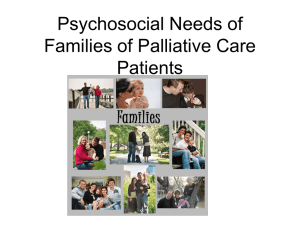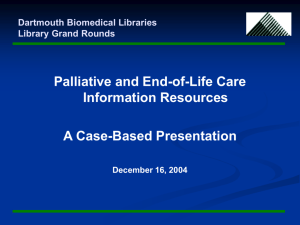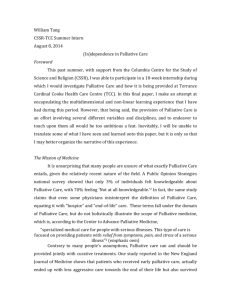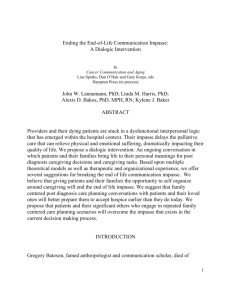Cross-Cultural Issues in End of Life
advertisement
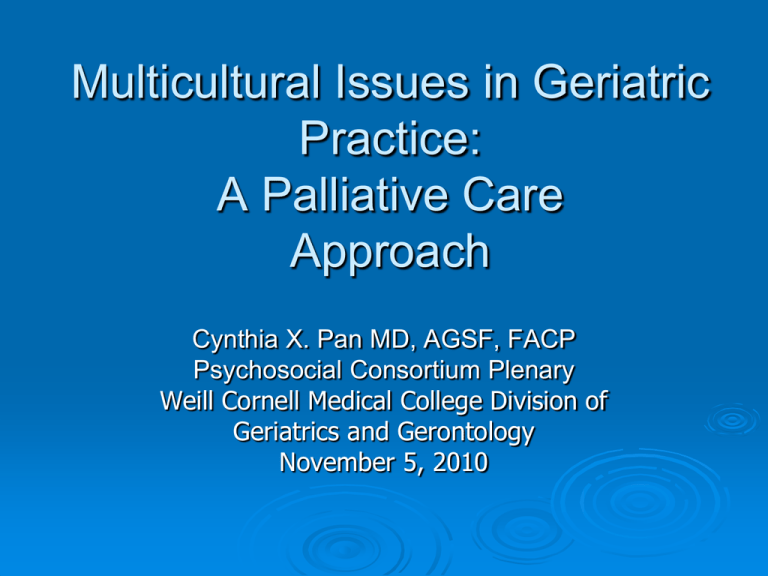
Multicultural Issues in Geriatric Practice: A Palliative Care Approach Cynthia X. Pan MD, AGSF, FACP Psychosocial Consortium Plenary Weill Cornell Medical College Division of Geriatrics and Gerontology November 5, 2010 Objectives Teach effective communication skills in eliciting the values and health care practices of the older adult in order to enhance treatment options and outcomes Present overview of multicultural issues for older adults in a palliative care setting. Review screening tools on cultural and spiritual history. Screen a video of an older adult, his family and treating physician and evaluate the interactions. Culture Culture is multidimensional and includes shared knowledge, beliefs, values, attitudes, rules of behavior, world view Context of culture dependent on social, religious, linguistic, dietary, geographical and historical factors as well as personal history, work experience, education, and economic status “Medicine” as a culture in itself • Sub-cultures within it, by specialty or discipline (Adams, 1995) (National Maternal and Child Health Center on Cultural Competency, 1997). 3 Cultural Competence Cultural competence comprises four components: Awareness of one's cultural worldview Attitude towards cultural differences Knowledge of different cultural practices and worldviews Cross-cultural skills Cultural competence results in an ability to understand, communicate with, and effectively interact with people across cultures. (Cross, Bazron, Dennis, & Isaacs, 1989). (Davis, 1997). Ref: Office of Minority Health; http://www.omhrc.gov/templates/browse.aspx?lvl=2&lvlID=15 Self Awareness Be aware of our own cultural values and beliefs – Cultural assessment tool Reaching out to Latino and Asian Elderly in Queens about Palliative Care & Hospice El Correo-Queens, April 2008 Palliative Care Planning Issues in Geriatric Care Identify key participants for decision making, with sensitivity to gender issues Choose explanatory model Determine language taboos including disclosure/truth telling Define filial responsibilities Understand the meaning of suffering and pain Elicit meaning of death 7 Communication in a Multicultural Practice Ask about preferred terms of address Offer respectful nonverbal communication Elicit decision making approach including: Attitudes towards disclosure and consent Knowledge about advance directives End-of-life decision making and intensity of care Ask about traditions/health beliefs and past medical care, past medical decisions Doorway Thoughts: Cross-Cultural Health Care for Older Adults. Vol 1/2. Jones and Bartlett Publishers. 2004. AGS. Blackhall et al. Ethnicity and attitudes toward patient autonomy. JAMA Cross Cultural Communication: ETHNIC(S) Template Explanation Treatment Healers Negotiate Intervention Collaborate Spirituality/Seniors/Support system Kobylarz. J Am Geriatr Soc. 2002 Sep;50(9):1582-9. Goals of Care: A G O O D Conversation G oals of care (given context of serious illness) O ptions O pinion/medical recommendation D ocumentation “VALUE” Guidelines For Family Meetings Value and appreciate family comments Acknowledge / address emotions Listen actively Understand the patient as person Elicit family questions Lautrette A, et al. N Engl J Med 2007; 356:469-478. http://depts.washington.edu/eolcare/instruments/index.html Cultural Preferences Caveat: Avoid stereotypes Use cultural preference as background Ask each older adult: • “This is what I understand about beliefs in your culture. Does this apply to you?” Consider potential roles multidisciplinary team members might play. • What are the disciplines’ strengths? African-American Cultures Slavery: poverty, persecution Belief in God: healing power, prayer, miracles Trust in health care services: limited Tuskegee Syphilis Experiment (Alabama) Decision-making locus: mixed Longevity - may trump quality of life years AD - legalized genocide, denial of care, premature death Gamble. Am J Public Health. 1997 Green et al. Ethn Dis. 2000 Corbie-Smith, et al. J Gen Intern Med. 1999 13 Mr. J. Mr. L. J. is an 86 yo African American male with advanced CAD, heart failure, diabetes, and chronic kidney disease. He was admitted for exacerbation of heart failure and pneumonia, which are controlled at this point. The medical team plans to discharge him to SNF, with a plan not to re-hospitalize. A palliative care consult was called. Mr. J. is upset because the medical resident repeatedly referred to him as “Larry” and addressed him in a loud voice as though he were hard of hearing. When Mrs. J. arrived, the medical team was in conference and not available to answer her questions. Mr. J Mr. and Mrs. J. had been asked to complete a DNR document ASAP. Mrs. J. was afraid that if she completed the DNR, doctors would no longer provide care to her husband. Mrs. J. was upset that the resident told Mr. J. that he should not be admitted to the hospital again as “nothing else could be done”. She feels Mr. J is in a great deal of pain that has not been adequately treated. Mrs. J. does not want her husband in an SNF. The closest facility is miles away from home, inconvenient for visits. It is a Jewish facility and Mrs. J was worried Mr. J would not like the food. Mr. J. Intervention: Mr. & Mrs. J. met with the palliative care and medical team and their questions were answered. They have no children but did have strong community church support, and two very involved nephews. Care plan: Mr. J. to be d/c’d with home hospice, church support, and medical f/u with hospice medical director. When pain was better controlled and his concerns were addressed, he agreed to DNR. Hispanic Cultures Death: natural part of the life cycle Familismo: welfare of the family Jerarquismo: respect for hierarchy Personalismo: trust borne of mutual respect Espiritismo: effect of good & evil spirits Presentismo: present orientation Sympatia: the meaning of nodding? Marshall et al. Health Care Ethics for the 21st C. 1998 Koenig & Gates-Williams. West J Med. 1995. Understanding cultural difference in caring for dying patients. Triandis et al. Simpatia as a cultural script of Hispanics. J of Personality & Soc Psychology. 17 1984 Asian & Pacific Island cultures Filial piety and family responsibility Treatment termination = ancestor murder • Fear of being judged by community Language taboos: “death/dying” • Associations with numbers, colors Avoidance of undue suffering Illness as a family event Good death: dying with a full stomach • Importance of feeding; history of disasters/starvation Death outside the home: wandering souls Death in the home: ? Omen, young children, crowding Candib. Truth telling and advance planning at the end-of-life. Fam Syst Health 2002 Yeo & Hikuyeda. Cultural issues in end-of-life decision making. Sage 2000 Blackhall et al. Ethnicity and attitudes toward patient autonomy. JAMA 1995. 18 …Asian & Pacific Island cultures 生 老病死 一 切 尽 在 不 言 中 19 Islamic Cultures Medication: “do something good”, hospitals are where people die Demanding behavior => the family cares Planning for death => brings on evil eye Privacy: resistance to stating wishes Truth telling: an unforgivable act 20 Cultural Competence Caveat: Avoid stereotypes Ask, don’t judge People are more alike than different Take advantage of strengths and expertise multidisciplinary team members might have. Video Mr. Kochi End of Life/Condolences As Teaching Moments With the older adult ask questions i.e.: "What's the most important thing you did?“ Offer to do an ethical will With the mourners reach out, ask for stories, describe your relationship with older person, include memories, express sympathy, offer non-judgmental view whatever end of life decisions were made Conclusion Cultural beliefs impact all aspects of life, but come into sharp relief during serious illness and end of life care Culturally sensitive & competent care includes an awareness of one’s own cultural identity and value preferences Simple tools are available to introduce and help guide the conversation General information on cultural diversity is critical but we are always working with individuals Cultural competence combines self-reflection and an ability to see other perspectives in order to create patientcentered treatment plans for those with serious illnesses or at the end of life “Every person is Like all others, Like some others, Like no other.” - Buddhist proverb References See handout




